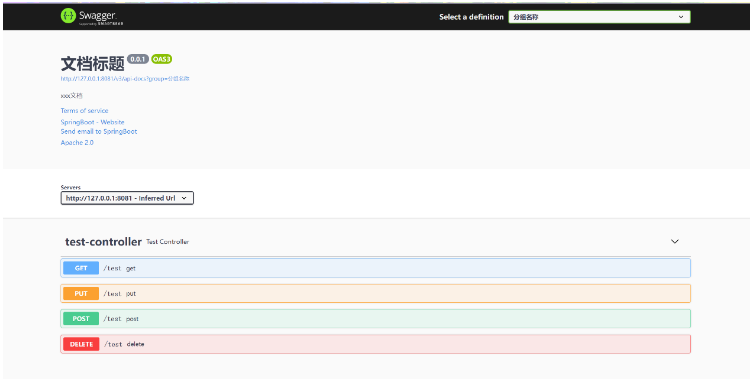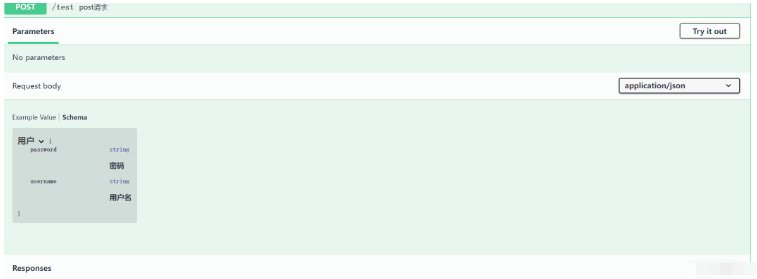
<!-- https://mvnrepository.com/artifact/io.springfox/springfox-boot-starter -->
<dependency>
<groupId>io.springfox</groupId>
<artifactId>springfox-boot-starter</artifactId>
<version>3.0.0</version>
</dependency>Note: The current SpringBoot version is 2.5.6, and Swagger3.0 is currently not fully compatible with SpringBoot2.6. x!
@RestController
@RequestMapping("test")
public class TestController {
@GetMapping
public Map<String, Object> get(@RequestParam String id) {
Map<String, Object> r = new HashMap<>(1);
r.put("id", id);
return r;
}
@PostMapping
public Map<String, Object> post() {
Map<String, Object> r = new HashMap<>(1);
r.put("code", 200);
return r;
}
@PutMapping
public Map<String, Object> put(String id) {
Map<String, Object> r = new HashMap<>(1);
r.put("id", id);
return r;
}
@DeleteMapping
public Map<String, Object> delete(String id) {
Map<String, Object> r = new HashMap<>(1);
r.put("id", id);
return r;
}
}@Configuration
@EnableOpenApi
public class SwaggerConfig {
private static final String VERSION = "0.0.1";
@Bean
public Docket createRestApi() {
return new Docket(DocumentationType.OAS_30)
.groupName("分组名称")
.apiInfo(apiInfo())
.select()
//要扫描的包
.apis(RequestHandlerSelectors.basePackage("com.example.swagger.controller"))
.paths(PathSelectors.any())
.build();
}
private ApiInfo apiInfo() {
return new ApiInfoBuilder()
// 设置标题
.title("文档标题")
//联系人
.contact(contact())
//描述
.description("xxx文档")
//服务
.termsOfServiceUrl("https://spring.io/")
//许可证
.license("Apache 2.0")
.licenseUrl("https://www.apache.org/licenses/LICENSE-2.0")
.version(VERSION)
.build();
}
private Contact contact (){
return new Contact("SpringBoot", "https://spring.io/", "email");
}
}| Annotation | Function | Use location |
|---|---|---|
| Indicates the description of the class. Common parameters | Class | |
| Describes the purpose of the method | Method | |
| It can contain multiple @ApiImplicitParam | Method | |
| Description Purpose of parameters | Method | |
| Represents information of a data class | Class | |
| Describe the properties of the data class | Properties | |
| Ignore a field so that It is not displayed in the document | Attribute |
@ApiModel("用户")
@Data
public class User {
@ApiModelProperty("用户名")
private String username;
@ApiModelProperty("密码")
private String password;
}@Api(tags = "测试接口")
@RestController
@RequestMapping("test")
public class TestController {
@ApiOperation("get请求")
@GetMapping
@ApiImplicitParam(name = "id", value = "测试用id", dataTypeClass = String.class)
public Map<String, Object> get(@RequestParam String id) {
Map<String, Object> r = new HashMap<>(1);
r.put("id", id);
return r;
}
@ApiOperation("post请求")
@PostMapping
public Map<String, Object> post(@RequestBody User user) {
Map<String, Object> r = new HashMap<>(1);
r.put("code", 200);
return r;
}
@ApiOperation("put请求")
@PutMapping
@ApiImplicitParam(name = "id", value = "put请求id", dataTypeClass = String.class)
public Map<String, Object> put(String id) {
Map<String, Object> r = new HashMap<>(1);
r.put("id", id);
return r;
}
@ApiOperation("delete请求")
@DeleteMapping
@ApiImplicitParam(name = "id", value = "delete请求id", dataTypeClass = String.class)
public Map<String, Object> delete(String id) {
Map<String, Object> r = new HashMap<>(1);
r.put("id", id);
return r;
}
}

 ##Integration Better UI-knife4j
##Integration Better UI-knife4j
<dependency> <groupId>com.github.xiaoymin</groupId> <artifactId>knife4j-micro-spring-boot-starter</artifactId> <version>3.0.3</version> </dependency>
@Configuration @EnableOpenApi @EnableKnife4j public class SwaggerConfig
The above is the detailed content of How springboot integrates swagger3 and knife4j. For more information, please follow other related articles on the PHP Chinese website!
 SpringBoot project building steps
SpringBoot project building steps
 What is the difference between j2ee and springboot
What is the difference between j2ee and springboot
 How to insert page numbers in ppt
How to insert page numbers in ppt
 Introduction to service providers with cost-effective cloud server prices
Introduction to service providers with cost-effective cloud server prices
 What is the difference between a router and a cat?
What is the difference between a router and a cat?
 How to change word background color to white
How to change word background color to white
 How to use the notnull annotation
How to use the notnull annotation
 clonenode usage
clonenode usage




